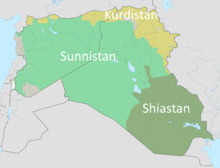Sunnistan, Shiastan and Kurdistan
It has been proposed by international powers that Iraq and Syria be divided into Sunnistan, Shiastan and Kurdistan.[1] Sunnistan would become a Sunni Arab state in northwest Iraq and eastern Syria, Shiastan a Shia Arab state in southeast Iraq, and Kurdistan in northern Syria and northern Iraq, whose people are Sunni Kurds and to a lesser extent, Christian Assyrians.
- Sunnistan
- Most of the Sunni Arab area in Syria and Iraq is occupied by government forces.
- Shiastan
- All of the Shia Arab area in Iraq is controlled by the Federal government of Iraq or Shiite militias.
- Kurdistan
- All of the Kurdish areas in Syria are controlled by Rojava, while all Kurdish areas in Iraq are controlled by the Kurdistan Regional Government.
See also
References
- ↑ Iraq — or Sunnistan, Shiitestan and Kurdistan Jake Flanagin, New York Times, July 7, 2014
Further reading
- Kaufmann, Chaim (2009). "Kurdistan, Sunnistan, and Shiastan" (PDF). Solomon Asch Center.
- "Creating Sunnistan: Foreign Affairs Calls for Syria and Iraq to be Balkanized". NEO. 2015.
- Hiltermann, J. (2007). "A new sectarian threat in the Middle East?". International Review of the Red Cross. 89 (868): 795–808.
- Eklund, K.; O’Leary, B.; Williams, P. R. (2005). "Negotiating a federation in Iraq". The Future of Kurdistan in Iraq: 235–50.
- O’Leary, B. (2010). "Thinking about Asymmetry and Symmetry in the Remaking of Iraq". Asymmetric Autonomy and the Settlement of Ethnic Conflicts: 183–210.
- Visser, R. (2008). "Historical myths of a divided Iraq". Survival. 50 (2): 95–106.
- Khaddour, K.; Mazur, K. (2013). "The Struggle for Syria's Regions". Middle East Report. 43: 269–.
- Visser, R. (2010). "The territorial aspect of sectarianism in Iraq". International Journal of Contemporary Iraqi Studies. 4 (3): 295–304.
This article is issued from
Wikipedia.
The text is licensed under Creative Commons - Attribution - Sharealike.
Additional terms may apply for the media files.
